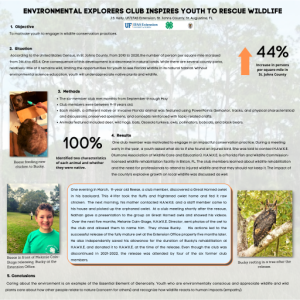2022 – Central District All Faculty Symposium – 4-H Youth Development
J.S. Kelly, UF/IFAS Extension, St. Johns County, St. Augustine, FL
Situation: According to the United States Census, in St. Johns County, from 2010 to 2020, there has been a 44% increase in the number of people per square mile (316.4 to 455.4). One consequence of this development is a decrease in natural lands. Without environmental science education, youth will underappreciate native plants and wildlife. Objective: To motivate youth to engage in wildlife conservation practices. Methods: The six-member Environmental Explorers club met monthly from September—May. A different native or invasive Florida animal was featured using PowerPoints (behavior, tracks, and physical characteristics) and discussions, specimens, and topic-related crafts. Results: Youth were able to name two characteristics of each animal along with whether it was native or invasive. One club member found an orphaned great horned owlet and contacted the local wildlife rehabilitation center. He independently saved his allowance for the five months the owl was in rehabilitation and donated it to the rehabilitation center at the owl’s release. Conclusion: Caring about the environment is an example of the Essential Element of Generosity. Environmentally conscious youth who appreciate wildlife and wild plants care about how other people relate to nature (concern for others) and recognize how wildlife reacts to human impacts (empathy).
 0
0

